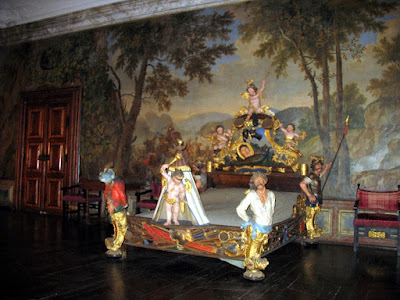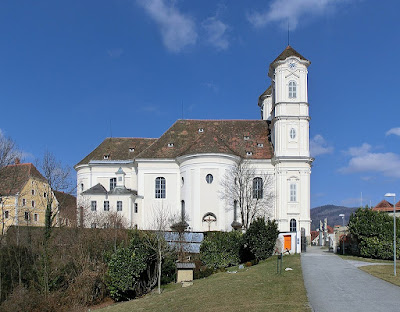Basilicas in Austria—Central
Basilica of the Nativity of Mary, Mariazell, Steiermark
Declared a minor basilica by Pope Pius X in 1907.
This Baroque church was built in the 17th Century to replace a 14th Century church that had been destroyed by fire. The church is considered the most important pilgrimage center in Austria and was the first church in Austria honored as a minor basilica. Pilgrims have come here since the 12th Century to venerate Our Blessed Mother.
The first picture is from Dreamstime and the others from Wikipedia.
Basilica and Abbey Church of the Assumption of Mary, Seckau, Steiermark
Declared a minor basilica by Pope Pius XI in 1930.
The Basilica serves as the church of a Benedictine abbey as well as a parish church. The Romanesque church was originally built in the mid-12th Century, although it has been modified over the years. It was once the cathedral church for the now-former Diocese of Seckau. Several members of the Habsburg family are buried in the church as are some bishops of the Diocese of Seckau. The church also has an alabaster image of the Madonna and Child that dates to around 1200. Legion has it that the founder of the abbey discovered the image in a tree and built the church on the site. It is the oldest miraculous image in Austria.
All pictures are from Wikipedia.
Basilica of Mary, Attnang-Puchheim, Oberosterreich
Declared a minor basilica by Pope Pius XII in 1951.
A castle church was on this site in the 13th Century. It was in a successor church dedicated to St. George that an image of Our Mother of Perpetual Help was brought in 1870. Pilgrims soon began coming here and the current Neo-Renaissance style church was constructed between 1886 and 1890.
All pictures are from Wikipedia.
Basilica of the Seven Sorrows of Mary, Linz-Postlingberg, Oberosterreich
Declared a minor basilica by Pope Paul VI in 1964.
A small chapel was built in the 1720s to house an image of Our Lady that had begun to attract pilgrims. The current Baroque church was constructed in the 1740s, although the façade was not added until 1774 and the spires not until 1892.
All pictures are from Wikipedia.
Basilica of St. Lawrence, Enns-Lorch, Oberosterreich
Declared a minor basilica by Pope Paul VI in 1970.
Churches have been on this site since Roman times and one served as cathedral for an early diocese. Today’s Gothic church was built in the early 14th Century. St. Florian, a Roman martyr, is buried in the church.
All pictures are from Wikipedia.
Cistercian Basilica of Our Lady of the Assumption, Rein, Steiermark
Declared a minor basilica by Pope John Paul II in 1979.
Rein Abbey was established in 1129 and is the oldest existing Cistercian monastery in the world. The 12th Century Romanesque abbey church was largely modified to a Baroque style in the early 1700s. The abbey library has 100,000 books, periodicals, and pieces of music—some dating to the Middle Ages.
All pictures are from Wikipedia.
Basilica of Our Lady of the Snows, Maria Luggau, Karnten
Declared a minor basilica by Pope John Paul II in 1986.
The church was originally built in the 16th Century after a farmer’s wife had a dream to build a church. The interior was modified in a Baroque style in the 1730s. The pulpit was built in the rococo style.
The first picture is from a local source and the rest are from Wikipedia.
Basilica of St. Florian, Sankt Florian, Oberosterreich
Declared a minor basilica by Pope John Paul II in 1999.
The Augustinian abbey was established in 1071 to honor St. Florian, a 4th Century Roman martyr. It is also dedicated to the Assumption of Mary and to St. Augustine. There are indications that an abbey may have existed here since the late 8th Century. The current Baroque buildings, including the church, were built between 1686 and 1751. Anton Bruckner was organist at the church from 1848 to 1855 and the church’s Boys’ Choir dates to 1071. The abbey’s library contains 150,000 documents and the abbey’s guest rooms have welcomed Pope Paul VI, Michael Haydn, and Franz Schubert.
All pictures are from Wikipedia.
Basilica of the Nativity of the Virgin Mary (also known as Our Lady of Consolation), Graz, Steiermark
Declared a minor basilica by Pope John Paul II in 1999.
The Baroque church was built on a ridge in the 18th Century. In the past it served as the church for a monastery—first Pauline and later Franciscan. It houses a statue of the Virgin Mary which has attracted pilgrims since the early 1700s.
All pictures are from Wikipedia.
Basilica of St. Michael the Archangel, Mondsee, Oberosterreich
Declared a minor basilica by Pope John Paul II in 2005.
The Gothic church began construction in the late 15th Century and continued until the early 18th Century. Once an abbey church, it replaced a 12th Century Romanesque building. The church is featured in the wedding scene in the movie “The Sound of Music.”
The top picture is from silverscreentours and the others are from Wikipedia.
Basilica of Our Lady of Loreto, Sankt Andra im Lavanttal, Karnten
Declared a minor basilica by Pope Francis in 2014.
A Loreto chapel was built on this site in 1647 by Dominican nuns. The current Baroque church was built between 1683 and 1686. The Dominicans left in 1782 and the Jesuits took possession in 1859. The Benedictines have administered the church since 2010.
All pictures are from Wikipedia.
Basilica of Our Lady of Sorrows, Weiz, Steiermark
Declared a minor basilica by Pope Francis in 2017.
A Romanesque church was built here in the 11th Century and was replaced with the current Baroque building between 1757 and 1776. A 15th Century Pieta was brought to the church in 1758.
All pictures are from Wikipedia.





















































No comments:
Post a Comment